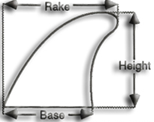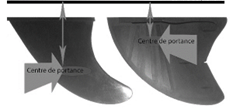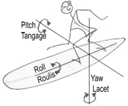influence and role of surf fins.
The board is an extension of the body of the surfer, the fins or drifts of the surf are its fins immersed in the water which guides it and propels it by deviating the trajectory of the flow. The role of the fins is of an importance that is sometimes underestimated by surfers, it is however a determining element for the maneuverability and acceleration of the surfboard. A fin is a wing that flies through the water.It generates lift and drag forces which act on the balance of the board, when the surfer begins to feel this active fin under his board he accesses a higher level of connection with the water, which amplifies his intuitiveness of trajectory..
You will find on this site : a brief history of the fin in the practice of surfing. Hydrodynamic forces produced by the aileron are drag and lift. These two forces are dependent on the shape of the profile, the surface and the relative velocity of the flow. a method for calculating these forces hydrodynamics is detailed on this site
 Surf fin profile
Surf fin profile
• L= Lift force perpendicular to the displacement of the fluid expressed in newtons
• D= Resistant drag force parallel to fluid displacement expressed in newtons
• α=Angle of attack
• A= Leading edge
• C =Reference chord length
• B= trailing edge
Three phenomena generate a sudden drop in grip, but their causes differ:
• Stall: Loss of lift resulting from too high an angle of attack. The boundary layer lifts off from the upper surface due to the excessive trajectory variation imposed by the excessive incidence. Recirculations fill the lift-generating depression.
• Cavitation: boiling, vaporization of the water at the level of the extrados generating a drop in pressure of the liquid below its saturated vapor pressure threshold. The speeds of the surf do not allow this type of loss of por-tance to be generated by vaporization.
• Ventilation: Suction of the surface at the level of the extrados of the fin. When the aileron is too close to the surface, the depression of the upper surface sucks in air and causes the lift to drop.
THE ACTIVE PARAMETERS OF THE FIN:
• The surface: Certainly the most important factor in terms of grip. A large surface area generates a large anti-drift force. The anti-drift force (lift) is proportional to the surface, but it changes with the square of the speed. Like sails, the surface of a daggerboard must be adapted to the speed of the fluid.
 A sail is proportioned to the speed of the wind, a surf fin must be adapted according to the speed of the surf.
A sail is proportioned to the speed of the wind, a surf fin must be adapted according to the speed of the surf.
This implies that the surface of the aileron must be designed for a given speed..
 Boards for fast as Guns, use reduced wing ailerons,
Boards for fast as Guns, use reduced wing ailerons,
 whereas the waves at low speed and low slope, practiced in longboard for example, require large sail areas to provide effective lift. The comparison to the surfaces of sails that are modified on a sailboat according to the speed of the wind gives an image of the adaptation according to the speed of the fluid. To obtain a fin favoring the slide, it suffices to reduce its surface until it no longer grips at low speeds, reached in figures with board braking, we can push the game to Finless. A variable geometry regulating the lift force according to the speed is an optimization which will be discussed in the optimizations chapter.
whereas the waves at low speed and low slope, practiced in longboard for example, require large sail areas to provide effective lift. The comparison to the surfaces of sails that are modified on a sailboat according to the speed of the wind gives an image of the adaptation according to the speed of the fluid. To obtain a fin favoring the slide, it suffices to reduce its surface until it no longer grips at low speeds, reached in figures with board braking, we can push the game to Finless. A variable geometry regulating the lift force according to the speed is an optimization which will be discussed in the optimizations chapter.
• aspect ratio : The distribution of the fin surface changes the center of lift application. "Base", "Rake", "Height", influence the overall character of the fin.

- The length of the base provides directional stability but also trajectory rigidity, the longer it is, the more "directional" the surf will be (the board's tendency to impose the trajectory and enlarge the radii of curvature of the turns, c is the inverse of manoeuvrability). We will see how the articulation of this base can be a source of optimizations using the stability of a large base without losing maneuverability.
- The height allows the fin to plunge deeply into the water. Let us remember that Simmons had proposed the twin to place the fins close to the rail in order to avoid the loss of grip in turns or verticality of waves tending to bring the central part of the board out of the water (Ventilation). Thanks to the new composite materials allowing higher elongations than wood, Greenought recenters the fin on the axis of the board and lengthens the height to ensure that the fin does not ventilate any more. Recentering the fin reduces the cant (see layout), but a center of lift that is too low increases the cant and slows down the passage from one rail to the other by leverage.



The right compromise between tilt effect, braking of the roll movement and ventilation is in the choice of the right height. In longboard waves, (low slope and curvature) it is useless to seek depth, it is preferable to keep the manœuvrability induced by a good sinking of the rail, and for radical maneuvers ventilating the central zone, side fins can be used under various layout options (See: layout and surf fin configurations).
• The Flex: We saw that by lengthening the shapes and giving Rake to his fins, Greenought brought the Flex to the fins. Maneuvers are made more flexible and unbalancing shocks are reduced by this shock absorber which stabilizes the trajectory in big waves. The Flex is also used by powerful surfers to store energy by exaggerating the maneuvering effort in order to recover the relaxation of the spring when exiting the turn.
• The profile: If we cut a slice of fin, we have a fish shape, it is its hydrodynamic profile. The fins are profiles with active extrados, because they are completely immersed in the fluid, we encounter 3 types of profiles:
o Symmetrical profiles :  This type of profile is used for the fins that must work on both sides in the same way, the central fin and built according to this type of profile.
This type of profile is used for the fins that must work on both sides in the same way, the central fin and built according to this type of profile.
o Flat profiles : ![]() This type of profile is easier to build in injection, only one half of the mold is enough to produce the part. It is used to produce side fins at low cost
This type of profile is easier to build in injection, only one half of the mold is enough to produce the part. It is used to produce side fins at low cost
o Cambered profiles : ![]() A cambered profile generates better performance (the performance of a profile is its lift / its drag, this is called the hydrodynamic finesse of the profile), provided that its extrados (profile hump) is on the side where you want to hang. This requires the use of profiles with opposite extrados on either side. If you want to deepen your knowledge of hydrodynamic profiles, see: Hydrodynamics of profiles with active extradoss.
A cambered profile generates better performance (the performance of a profile is its lift / its drag, this is called the hydrodynamic finesse of the profile), provided that its extrados (profile hump) is on the side where you want to hang. This requires the use of profiles with opposite extrados on either side. If you want to deepen your knowledge of hydrodynamic profiles, see: Hydrodynamics of profiles with active extradoss.